
6 minute read
Writes of Way
Writes of way... Literature
Lorna Hogg continues her literary-themed walks, tracing the rich heritage to be found in Dublin
St. George’s Church, better known as The Peppercanister, was the childhood parish church of Elizabeth Bowen who lived in nearby Herbert Place
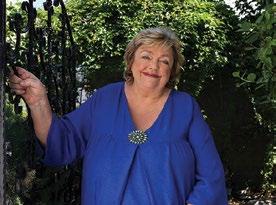
Maeve Binchy taught at Miss Meredith’s School at No. 1 Pembroke Road in the 1960s
We have one of the world’s greatest literary capitals- but how much of it have you explored? Whether your taste is for comedy, history, philosophy, social commentary or ground breaking literature, it’s easy to walk in your favourite writer’s footsteps, inspirations and memories. The city has so many famous and well loved authors, that your only problem is choice, best solved by dividing the city into north and south side.
Added to the variety of choice is the fact that those authors’ haunts are largely unchanged. From red brick Ballsbridge, the formal Georgian houses of Merrion, Parnell and Fitzwilliam Squares, to Bohemian Dublin around the tree lined Grand Canal, much landscape and literary inspiration remains.
Also, you’ll quickly find that while Paris may have its bistros, Dublin has its pubs, ideal for breaks whilst tracing literary his-tories. So, whether you want to simply stroll, or to absorb the atmosphere of these areas which inspired so many writers and dramatists, there is plenty to inspire, and enjoy.
Southside saunters
Take the DART to Pearse Street station, on Westland Row –where Oscar Wilde was born, at No. 21 in 1854. Kennedy’s pub is here, well known to Behan, Joyce and Beckett. Follow the road round the corner to Lincoln Place, where Ulysses fans can spot Sweeney’s Chemists. Clare Street was the site of Greene’s, one of the city’s iconic bookshops, complete with winding stair, dating from 1843. The building now holds Henry Jermyn tailoring, but the famous glass portico and wrought iron struts remain. unchanged throughout the times of its impressive literary roll call. Goldsmith and Edmund Burke, Oliver St. John Gogarty, Oscar Wilde, Bram Stoker, Synge, Brendan Kennelly and Beckett studied here – and Trinity graduate and Irish American writer J.P. Donleavy set his famous novel The Ginger Man here.
Leave Trinity by Front Gate, and walk across to Fleet St., for The Palace Bar, one of the city’s most famous writers’ pubs. Then walk up Dame Street to the Cork Hill entrance to Dublin Castle. Cross over to the Castle’s outside walls and walk up to the site of Hoey’s Court, birthplace of Swift, and marked by a plaque in Little Ship Street. Nearby lies St. Patrick’s Cathedral, which holds his death mask and grave. Next, walk down the atmospheric St. Patrick’s Close, to Marsh’s Library, Dublin’s first public library. Swift, as well as James Joyce, Charles Mangan, and George Moore were regulars. Swift’s home as Dean of St. Patrick’s, The Deanery, is also here. Don’t miss the nearby St. Patrick’s Park, containing plaques to a variety of writers ranging from Brendan Behan to Oscar Wilde.
Just a short walk takes you back to St. Stephen’s Green, which has several literary statues, including Yeats and Joyce. Grafton Street is worth a detour for Bewley’s Café, where Kavanagh and Maeve Binchy and generations of students were regulars, Explore pub territory - The Bailey and Davy Byrne’s, famed for their Joycean connections, face each other in Duke St.
In Chatham St., Neary’s, frequented by Brendan Behan and actor Jimmy O’Dea, and the Dawson Lounge were also popular, whilst Mc Daid’s attracted Behan, Kavanagh, Donleavy and also younger writers. The Shelbourne Hotel was another literary haunt, from Elizabeth Bowen and George Moore to Brian Friel. It also featured in George Moore’s novel, `A Drama in Muslin.’
Bram Stoker, author of Dracula, lived in the Crescent, Fairview
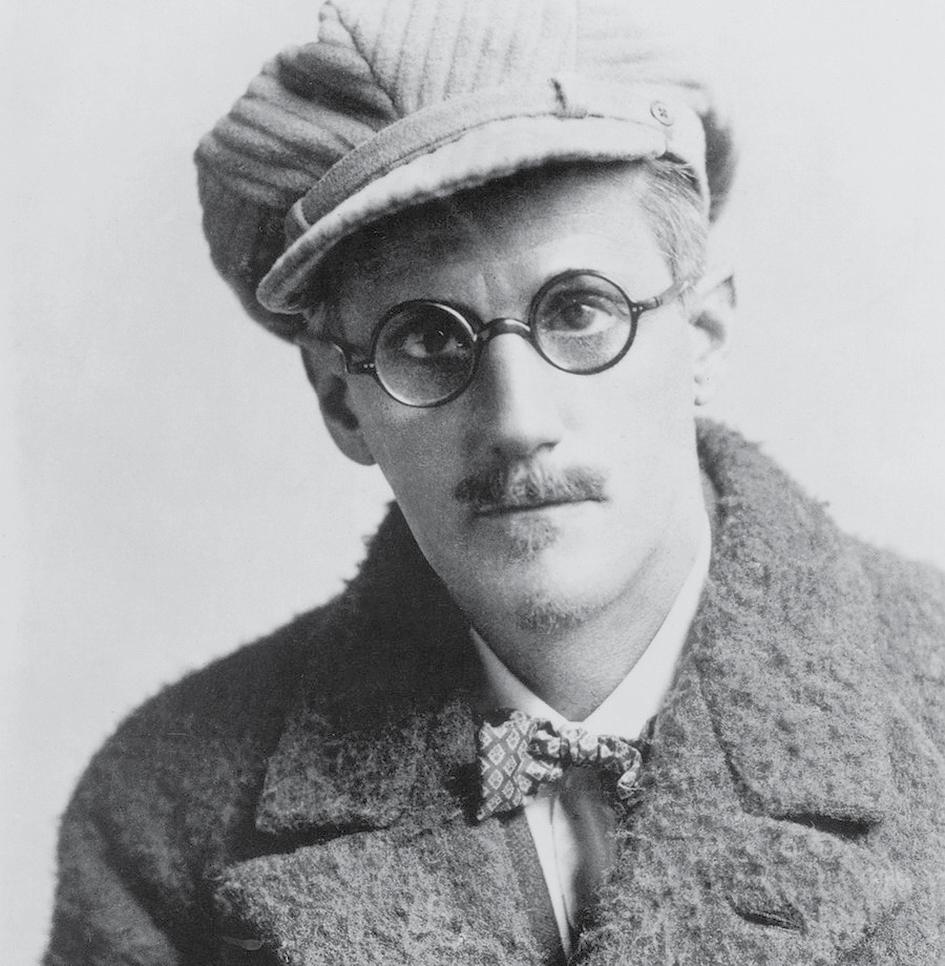

James Joyce was regular to Marsh’s Library, Dublin’s first public library
Continue on up Merrion Row, past Doheny and Nesbitt’s pub, popular with politicians, artists and writers including Neil Jordan, and turn on to Ely Place. Popular with the city’s Edwardian writers, St John Gogarty lived in No 15 and George Moore in No 7. The Dublin United Arts Club, is nearby, at No. 3, Fitzwilliam St. Upper, familiar for writers ranging from Yeats and St. John Gogarty to Percy French.
Merrion Square was home to many Dublin’s writers. Daniel O’-Connell lived at No.58, Sheridan le Fanu at No. 70, Yeats at No. 82. and Oscar Wilde at the beautiful No. 2 corner house which is now the American University. As a child, he and his brother played in the Square with the children of Sheridan le Fanu, and Wilde’s statue now gazes out towards his old home. Nearby lies The National Gallery, a popular retreat of George Bernard Shaw, and also Beckett, who lived at No. 6 Clare St.
The Peppercanister Continue on around the Square to Lower Mount Street. With a view framing St. George’s Church, nicknamed The Peppercan-ister, it was the childhood parish church of Elizabeth Bowen. Jack Yeats’s funeral was also held here. In 1954, the Pike The-atre in nearby Herbert Lane, staged Brendan Behan’s The Quare Fella and in 1957, the controversial The Rose Tattoo.
Behind the church lies Dublin’s literary Bohemian heart, the still atmospheric ‘Canal’ area. During previous centuries, barges plied their trade on this leafy artery of the Grand Canal, criss crossed by some picturesque bridges. The drawing room light at Elizabeth Bowen’s childhood home at No.15 Herbert Place, was dappled by canal reflection. No. 25, over looking one of the prettiest crossings, Huband Bridge, was the
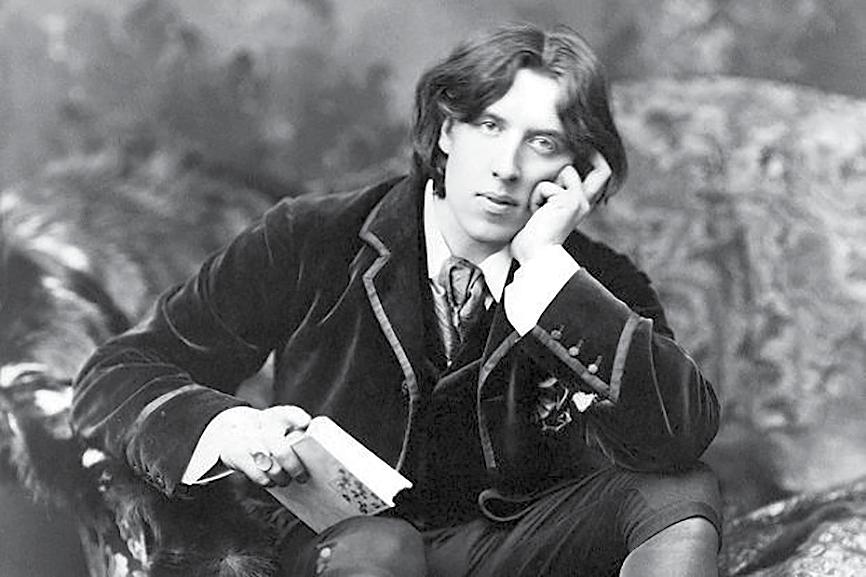
Oscar Wilde lived at No. 2 Merrion Square corner house which is now the American University
home of Flann O’Brien/ Brian O’Nolan. Patrick Kinsella was nearby at No. 47 Percy Place. This canal stretch inspired many writers - Joyce’s character Daedalus mused here, walking along its tow paths, and The Ginger Man wove his way home under the flickering gas lights.
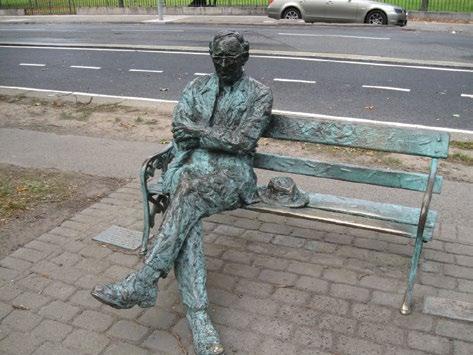
Patrick Kavanagh’s seated statue on the Grand Canal near Baggot Street Bridge
from the late 1940s until 1989, its customers formed a Who’s Who of Irish literary talent, plus politicians, newspaper editors and intellectuals. Brendan Behan, a resident at 15 Herbert Street, and also 18 Waterloo Road, set his watch by the clock at the junction with Mespil Road. Along with Patrick Kavanagh, who lived at 62 Pembroke Rd, he drank at Mooneys’ pub, whilst Searsons and the Waterloo were also popular spots.
Continue on to the Mespil lock, past the statue of Kavanagh, to the Court Apartments, Wilton Place, home to Frank O’Connor. Liam O’Flaherty was a neighbour. Around the corner, Fitzwilliam Place leads to Lad Lane, where master short story teller Mary Lavin was an ‘early adapter’ in her converted mews house.
At Leeson Street, you can continue along the canal, to Camden Street, for 33 Synge Street, birthplace of George Bernard Shaw. Alternately, return to Baggot Street Bridge, and walk through Ballsbridge, past No. 1 Pembroke Road, where Maeve Binchy taught at Miss Meredith’s School in the 1960s, and then down to Lansdowne Road DART station. Strumpet City fans can take the new Dodder Park Walkway down to the old Pump House, and go along Philomena Terrace to 20 Bath Street, Irishtown, where James Plunkett lived.
MORE INFORMATION
Dublin: One City, One Book Festival - April
Dublin Book Festival - November.
Marsh’s Library – www.marshlibrary.ie
www.writersmuseum.com
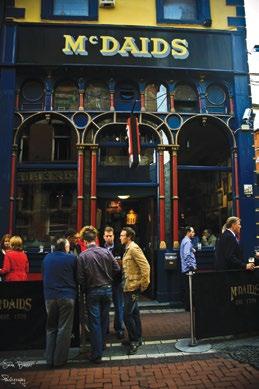
www.dublinpubcrawl.com
www.walkingtours.ie
Mc Daid’s in Chatham Street, off Grafton Street, was a haunt for Brendan Behan, Patrick Kavanagh, JP Donleavy among other younger writers St. Patrick’s Cathedral holds Jonathon Swift’s death mask and grave.
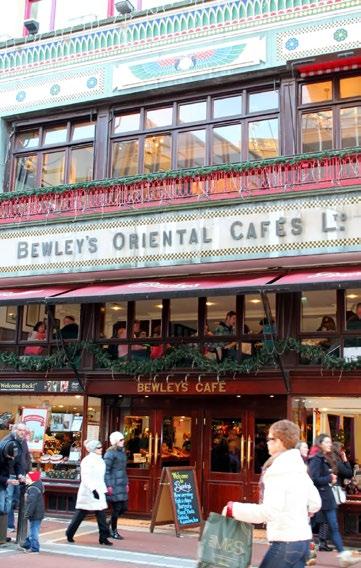

Grafton Street is worth a detour for Bewley’s Café, where Maeve Binchy and generations of students were regulars










